Types of Lizards
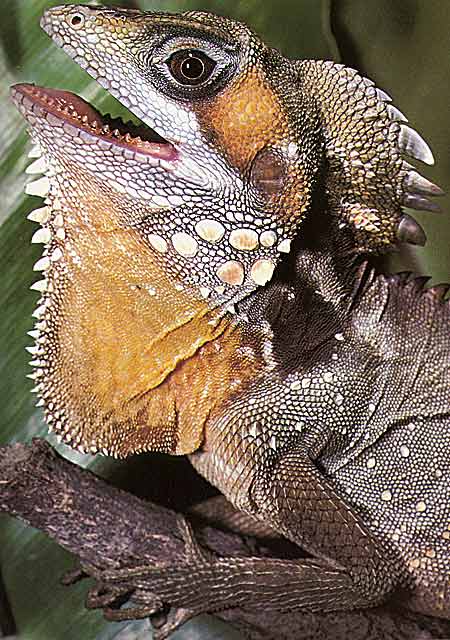
Boyd's Rainforest Dragon
Lizards are reptiles, or members of the class Reptilia, and are descendants of the dinosaurs that once ruled the Earth. They inhabit all of the continents apart from Antarctica, from sea level to heights of 16,500 feet (5000m). Lizards live in diverse environments and are the most geographically widespread of the reptiles. That makes them the largest group of reptiles with about 5000 species. They have walked the earth for some 200 million years.
Reptiles have the following physical features: they have vertebrate, lungs, and scales or plates. They are cold-blooded, getting all of their heating from the environment (the sun) which can be deadly during cold spells. What could be good about that? Well, this allows the reptiles to eat much less than a mammal of the same weight might. In the desert, for example, this might be useful in terms of competing for food. Also, since they don't need so much energy from food to heat themselves they can spend more time basking and taking in the sights. However, poor temperature control means they need to be active when the temperature is suitable and for this reason most are active during the day.
The classification or taxonomy of lizards can be subject to interpretation and change but here are the major groups and families:
- Diploglossa: knob-scaled or xenosaurs; glass and American legless lizards
- Gekkota: geckos, blind and legless lizards
- Iguania: iguanas, agamas, anoles, chameleons; casquehead, collared, leopard, earless, spiny, tree, wood, side-blotched, neotropical ground and horned lizards
- Platynota: gila monsters, earless monitors and monitors
- Scincomorpha: skinks, tegus; spinytail, plated, spectacled, wall, and night lizards
Most lizards are four-legged, but some have only two legs and even a few are leg-less. Their size ranges from 2 in to 10 ft in length. There are 2 species that are venomous, the gila monster and the Mexican beaded lizard.
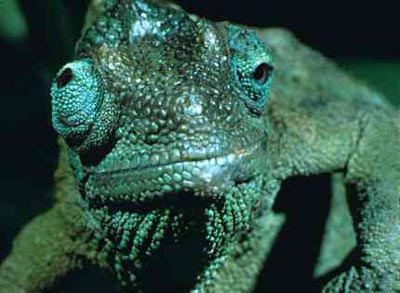
Chameleon
Some lizards change colors very quickly to match their environment, like the chameleon. Their colors are also affected by the sun. Often, when basking in the sun, the colors of a lizard's skin can become bright and vibrant like the collared Lizard. A cold lizard may be dark and colorless.
Distinct colors, aside from simply being interesting, like having a blue tongue, a bright red dewlap, or yellow spots, may help lizards identify each other and even communicate. Lizards have very keen eyesight and they also use body language posturing and gestures such as head-bobbing to communicate with each other.
See more about Chameleons

Collared Lizard
You may notice that the collared lizard pictured above is shedding a layer of old skin. The skin or scales of a lizard is made up of keratin. This substance is also what human fingernails are made of.
Collared lizards are known to be aggressive and they eat other species of lizards.
The Tale of the Amazing Regenerating Tail
Encountering a dangerous predator, some lizards can voluntarily shed their tails into one or more pieces. Prior to losing the tail, some, such as the Texas banded gecko, slowly wave the vertical tail in the air from one side to another. This tactic is employed to cause the snake or other predator to focus on the tail instead of the more vulnerable head or body. The shed tail itself shakes convulsively for several minutes, further distracting the predator and improving the lizard's odds of escaping unharmed with one less body part. Species capable of this feat have a "fragile" tail, with fracture planes in one or more of the vertebrae. A wall of connective tissue or cartilage passes through each such vertebra, making a weak point, where muscles and blood connections are also modified to allow an easy break.
After shedding a tail the a new one slowly grows back, but never quite the same as the original. It may not have all the vertebrae with fracture planes, but it has all the functions of the original which assist in running, swimming, balancing or climbing, camouflage, courtship, mating and fat-storage. If the tail breaks at any other place than a fracture plane, regeneration is slight. Losing a tail, though it may save the clever creature's life, is not without costs. For example, the fat stored in the tail is normally broken down and used for growth and maintenance when food is scarce or no longer available, especially in winter or drought. Some species, like the Australian marbled gecko, is known to live longer when it has a tail. In addition, the fat stored in a female's tail appears to be important in yolk production; individuals lacking tails produce eggs with lower mass and less energy, and the offspring survive less well. Tail regeneration itself may require substantial energy, an expenditure that could be used instead for reproduction, perhaps making larger eggs. In the Texas banded gecko, at least, reproduction is known to have energetic priority over tail regeneration. This may be true for other short-lived species of lizards, especially when the probability of producing offspring is low. At least some species in most of the families of lizards are capable of tail-loss except for all species of chameleons, beaded lizards, the Bornean earless lizard, monitors and xenosaurs.
Diet
Many lizards are fearsome predators themselves, feeding on insects, birds and even mammals and other members of the reptile family. The most impressive predator would be the Komodo dragon, that is a scavenger as well as a predator, and can overtake goats and even water buffalo. Its teeth are compressed with sharp edges, resembling those of sharks. The dragon literally rips chunks of flesh from its large prey. It also possesses a highly flexible skull that allows it to swallow big bites of flesh. The Caiman lizard eats snails. Its rigid skull and tough teeth provide it with the power for breaking shells. A small percent (about 2 percent) of known species of lizards are primarily vegetarian. Iguanas consume a wide variety of plant material, especially as adults. The marine iguana of the Galapagos Islands may win the vegetarian prize for their deep diving efforts to find plant material. Some skinks feed on plants and fruits. Other species change their diets as they grow and with the seasons to take advantage of the available food supply.
Territorial skirmishes are common among lizards and a number of body movements indicate territorial ownership or aggressive intent such as: color changes, body inflation, dewlap unfolding, push-ups, jaw-flapping, tail-waving and head-jerking. Sometimes such behavior can leave posturing lizards vulnerable to vigilant predators. Males are often looking to hold a nice territory for mating. Females are also territorial in some species.
Body language is also a big part of mating rituals. Head-bobbing, tail-waving, dewlap-moving, back-arching and dancing may be crucial for mating communication, whether it be accepting or rejecting mates. Other species can use chemical secretions or vocalizations to communicate mating information. There are species of lizards that have no males! The females produce eggs that need no fertilization. This, however, limits the genetic variety of the species.
Most lizard parents don't care much for their offspring. There are a few species that may watch over their eggs. Otherwise, mating and finding a good spot to lay eggs is considered a job well-done.

Common Iguana
Unfortunately for lizards, life on the earth populated with humans is not all about good times. Central Americans like to eat the iguanas and think they taste good, calling them "tree chicken". In Central America, the black iguanas are called garrobos, and the green iguanas are called iguanas, so you might find "sopa de garrobo" or "iguana soup" on some menus. Charbroiled tail of iguana can also be found. The common method of hunting is with a slingshot. Freshly killed prey is often held up for display alongside the highway by the hunters, in order to entice buyers. Another lizard, the uromastyx or spiny-tailed lizard, is commonly eaten in many countries from Northern Africa through the Middle East and in India.
Common Iguanas are not bad swimmers. When attacked, an iguana may jump from a tree or rock into the water to swim away.
Marine iguanas live only on the Galapagos Islands and it is thought that they arrived to the islands by floating from mainland South America on debris. They can dive as deep as 50 feet (15m) underwater to feed on algae. They can stay under water for up to 20 minutes. In order to stay down for very long in colder temperature water they have to first heat up their bodies in the sun, slow down their hearts in the water, then re-heat in the sun again once they get out.

Basilisk - Source: Tad Arensmeier
Basilisks are great runners. When in danger, these lizards start running upright on their back legs. They can even run fast enough to walk, or run really, on water. This has caused them to be referred to as the "Jesus Christ Lizard".
See more about the Jesus Lizard
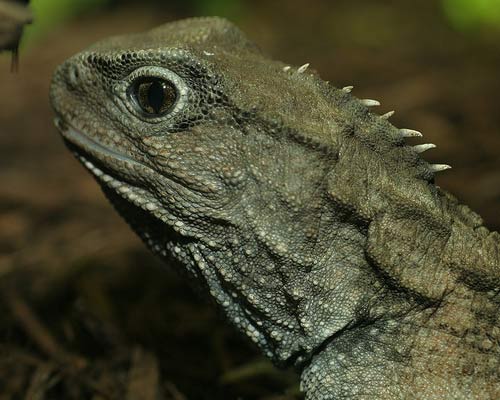
Tuatara - Source: Tad Arensmeier
The tuatara has virtually remained the same for over 140 million years. The tuatara is a reptile, but not in the lizard family, it is part of the family Rhynchocephalia (which translates to Beakheads) which appeared over 220 million years ago. All the Beakheads, besides the tuatara - 2 species, became extinct about 60 million years ago. They are very rare, nocturnal animals.
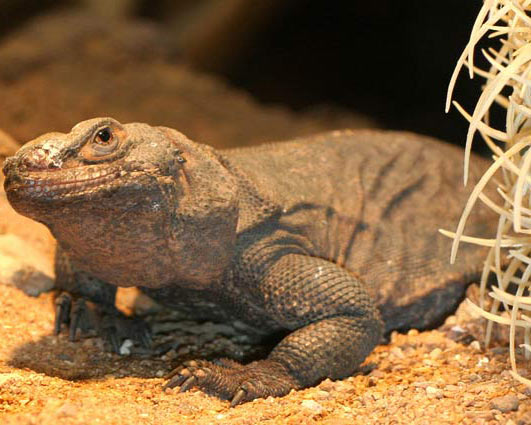
Chuckwalla - Source: Tad Arensmeier
Chuckwallas are rock dwellers in the Southwest USA and Mexico. When threatened, they crawl into crevices and puff-up their bodies so that they are tightly wedged in and nothing can yank them out.
Lizards have crude third eyes on top of their heads that senses whether it's day or night.

The "horned devil lizard" shoots blood from its eyes to scare away predators.
Also see the similar thorny devil

A flying dragon lizard avoids danger by opening two large, winglike flaps of skin and gliding from tree to tree. The lizard steers and brakes with its tail. The large flaps are supported by elongated ribs which they can expand and retract. The wings are brightly colored and for this reason they are also called the "butterfly lizard".

Bearded Dragon Lizard
The Bearded Dragon is one of the most common lizard pets, along with iguanas. They are generally docile.

Gecko
The Gecko is the only lizard and reptile that speaks or barks. Many species are well known for their specialized toe pads that enable them to climb smooth and vertical surfaces, and even cross indoor ceilings with ease. There are an estimated 2,000 different species of geckos worldwide, with many in existence still yet to be found. Just recently a 100-million-year old gecko species was discovered in the Eastern Himalayas.
One gecko with distinct coloring and bark! - Tokay Gecko

Frilled Lizard
This defensive posture of the frilled lizard is intended to increase its apparent size and intimidate adversaries. They open their frills around their necks and hiss when threatened.

Old-Man Lizard aka Casque-Head Lizard aka Hernandez's Helmeted Basilisk (Corytophanes Hernadezi) - Belize - Source: Kristiina Hurme
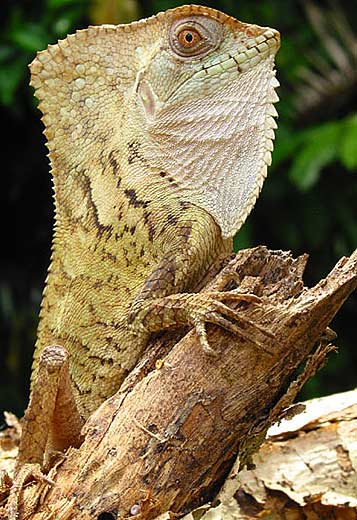
Old-Man Lizard aka Casque-Head Lizard aka Hernandez's Helmeted Basilisk (Corytophanes Hernadezi) - Belize - Source: Kristiina Hurme
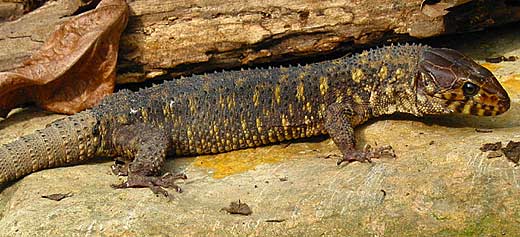
Yellow-spotted Night Lizard (Lepidopyma Flavimaculatum) - Belize - Source: Kristiina Hurme

Blue Tongued Skink

Asian Agamid
Agamids are lizards of the Old World. There are more than 300 different species in Africa, Asia and Australia. Their counterpart in the Americas would be the Iguanidae. Some agamids enjoy the water and others prefer the trees.
No comments:
Post a Comment